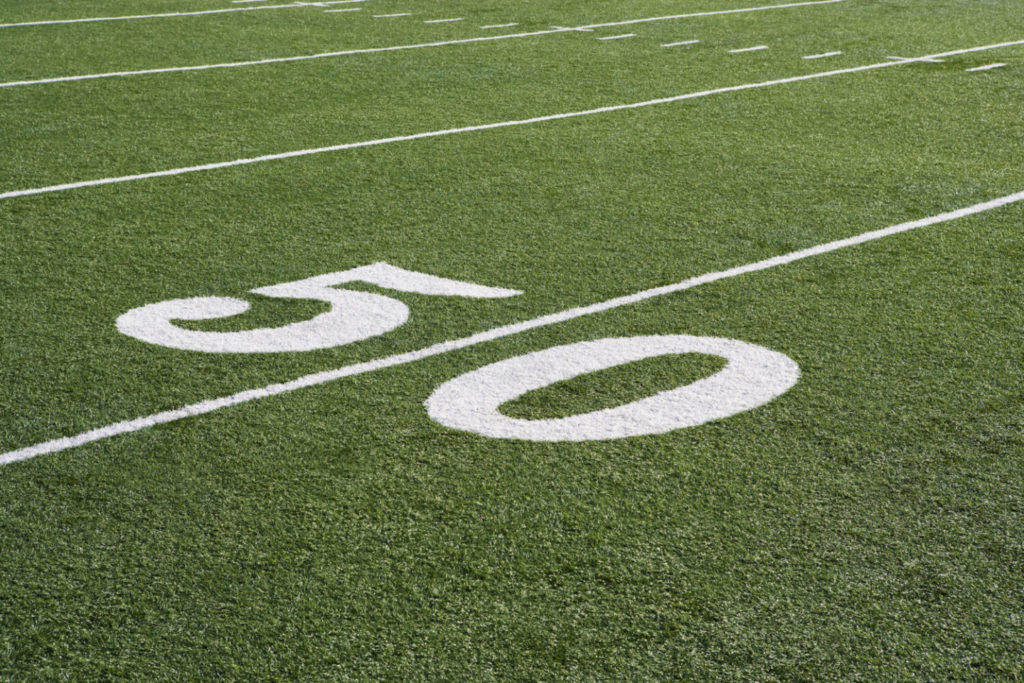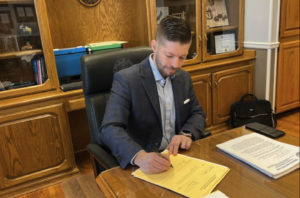Kansas legislature considers bill to modify sports competition between public and private schools
(The Sentinel) – Last year, the Kansas State High School Athletics Association — which governs all high school sports in Kansas — adopted new rules intended to level competition between public…

(The Sentinel) – Last year, the Kansas State High School Athletics Association — which governs all high school sports in Kansas — adopted new rules intended to level competition between public and private schools in the state.
Earlier this month, the Kansas State House of Representatives Education Committee heard testimony on a bill — HB 2003 — which would make those rules official in the 2023-24 school year.
The bill would amend section 1, paragraph 5 of K.S.A. 72-114 to read “Establish a system for the classification of member high schools according to student attendance and other factors.” (Emphasis in original.)
Proponents say the changes are necessary to correct an imbalance between public and private schools in athletic competition.
As the Sentinel reported in May of 2022, in the 2020-2021 school year, private schools in Kansas — while accounting for less than 8% of all high schools — won 36% of all state championships in which they were eligible to compete, and a review of the history of state championships shows a decidedly private school flavor among the leaders in Classes 2A-5A.
As a result, KSHSAA adopted a proposal that would move a handful of private schools to a higher classification through the use of a “multiplier” toward the school’s enrollment.
The KSHSAA sports competition proposal
The proposal is three-phased; however, the second and third phases are not activated unless the first one is reached.
- Championships Won: If a school has earned 10 championships in any sport over a 5-year period, a multiplier of .3 is added
- Location: If a smaller school is located within a 5A or 6A district, another .3 is added. If located within a 3A or 4A district, add .15. The purpose is to dissuade private schools from recruiting public school athletes.
- Socio-economic: If a private school has fewer than 20% of its student body receiving free- or reduced-price lunches, another .15 is added to its population total as it signifies a more prosperous school with greater resources to support its athletic and scholastic programs.
Testimony
Bill proponent Rep. Tim Johnson, a Johnson County Republican, said the bill is not about any particular rule but rather designed to codify what KSHSAA had gone through “extensive vetting for.”
Johnson, who is both a teacher and a coach, said KSHSAA had studied a number of plans to correct what had been seen as a competitive imbalance and noted the KSHSAA board, a majority of the 355 KSHSAA member schools, and the state board of education had all voted in favor of the proposed rule changes the bill would make possible.
“It’s a very difficult and challenging activity to make things fair,” Johnson said. “But the association has come to the conclusion that what is in place right now is not necessarily fair for all.”
KSHSAA Executive Director Bill Faflick noted that the rule changes would have an effect on regular season games or league assignments but apply only to post-season games such as regional, sub-state, and state championships.
Basehor-Linwood Head Football Coach Rod Stallbaumer also spoke in favor of the bill.
“I’ve been teaching and coaching at Basehor-Linwood for nine years, and we kind of have a unique perspective at our school, where we often do end up playing private schools in the playoffs,” he said. “In seven of the nine years I’ve been there, our season has ended in the playoffs against a private school.”
Stallbaumer argued that, because public schools are required to educate every student living in its district — which includes special education services private schools may, but are not obligated to offer, as well as low-income students, enrollment figures aren’t necessarily a fair comparison between schools.
He also noted that the cost of private school “oftentimes drives away students who wouldn’t be participating in athletics anyway.”
Stallbaumer said he had researched which public schools were having success against private schools — particularly in the Kansas City area.
What he discovered was that only Class 6A Blue Valley and 5A Mill Valley had had any real success. Blue Valley had won 61% of their games against private schools in the last nine years. Mill Valley, which has won six of the last eight 5A state titles, has a 54% winning percentage against private schools — but has gone 0-for-4 against class 4A Bishop Miege.
Another proponent noted that class 6A schools overwhelmingly voted against the proposal — he said because there currently are no private schools which compete at the highest classification level.
Opponents say this is simply unfair to private schools — in part because it targets private schools specifically and does not apply the same multipliers to public schools.
Jamie Finkeldei, president of the Kansas Association of Independent and Religious Schools, said the proposal — rather than teaching student athletes life skills and character development — “This proposal says to all the kids in Kansas that it is more important to win state championships than it is to participate. This is the exact opposite message KSHSAA is trying to send.”
Moreover, Finkeldei said, the proposal only looks at private vs. public.
“(The proposal) punishes private schools who have won five or more state championships in the last five years,” Finkeldei said. “There are 28 private schools in the state. Between 2015-2021, they won 25% of all state championships. However, there are 23 public schools who meet the criteria of winning five state titles in the last 5 years. Between 2015-2021, those 23 public schools won 28% of all state championships.
“Why are those 23 public schools not subjected to the same multiplier? Second, what do all of these successful schools have in common?,” he continued. “If five state championships in the last five years is too many, then there is no fair or just reason why KSHSAA should not apply the modifier to all schools. The common denominator between almost all these successful schools is that they are almost all suburban schools with low free and reduced lunch counts.”
Finkeldei also noted that “if what the advocates for this proposal suggest is true, that higher classifications lead to tougher competition, the real losers in this proposal are the low-income kids in Wichita, Topeka, and Kansas City who will be facing tougher competition. 6A is primarily made up of inner-city schools from these three cities, and this proposal will primarily push 5A private schools up to 6A.
“To characterize this issue as exclusively a private vs. public school issue is patently unjust.”
Accusations of recruitment bite both ways
Bill proponent Johnson was quoted in August of last year claiming active recruitment of student-athletes by offering scholarships to attend the school.
“I have no problem with a parochial school recruiting within its diocese or members of their faith,” Johnson told Fox4 of Kansas City. “They should do that, but most of these star Division I athletes that are going, religion has nothing to do with it. That’s a principle in the ideas of private schools.”
However, proof of active recruiting — which is illegal in Kansas — has never been offered.
Kapaun Mt. Carmel Catholic High School Principal Chris Bloomer told the committee that the only active recruiting of the Wichita Diocese is in kindergarten.
“At Kapaun Mt. Carmel, and in fact, all four high schools in the Diocese of Wichita, we operate off a stewardship program that supports our students in attending our schools,” Bloomer said. “Ninety-nine percent of our students graduate from one of our many feeder schools, 99% of them are Catholic, and 99% of them have been with us their entire educational career. The only recruitment that actively occurs is of families who are entering kindergarten.”
However, he admits recruiting and transfers are of concern.
“I am not here to say that recruiting and transfers are not an issue,” Bloomer said. “In fact, I agree that they are. However, it is a much larger issue than public vs private.”
Bloomer, and other opponents, noted that in May of last year, Kansas Governor Laura Kelly signed an open enrollment bill allowing — starting in June 2024 — all districts to accept any student that has the means and the transportation to attend.
“I think we can all agree we need to make some changes to the transfer rules and private schools want to be part of the comprehensive solution,” Bloomer said. “If the recent changes in NCAA transfer rules show us anything, it is that young people today want and expect to be able to move schools as often as they want for whatever reason they want.
“That is not what high school sports is about. Open enrollment, interdistrict transfers, what constitutes a bonafide move, blatant recruiting tactics, and parents demanding that sports are a legitimate reason to transfer are all issues that have to be addressed. But changing the classification system and adding a success modifier to only private schools stands not only to punish private schools for these issues, it ignores that these are issues in the public schools as well.”



